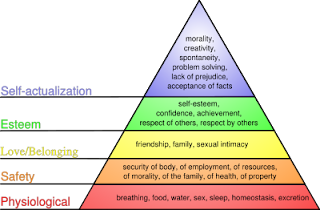We are probably all familiar with the famous Maslow’s Hierarchy of Needs. It was developed by Abraham Maslow in America during the 1940-50’s. While times have changed since then his Hierarchy of Needs theory remains valid today for understanding what motivates people and is useful in management training, as well as personal development. In fact Maslow’s ideas about the responsibility of employers to provide a workplace environment that encourages their employees to fulfil their own goals and develop their personal achievements are today more relevant than ever.
Maslow’s first theory concerned five levels of basic needs, and while this has been augmented to seven and nine levels, it is the 5 level model that we most connect with.
We know that when we tap into the values and desires of individuals and connect those values with the values of management and the organisation, we are working with the higher levels of The Hierarchy of Needs, and when that happens employees are motivated to give their best.
From childhood we have been familiar with incentives such as “Clean your room and you can go surfing” While it may look like bribery it is really an incentive for you to do something that you may not enjoy.
Incentives are everywhere; but they tend to be effective only when they trigger an emotion. The emotion triggered by the incentive should outweigh the negative feeling raised by performing the task. In the example, my love for surfing and my wish to be surfing outweighs the distaste I feel for cleaning up my room. It therefore becomes a powerful incentive for me.
Every organisation has the opportunity for employees to improve their performance ~ And if you’re a manager or in upper level administration, motivating your team to achieve that improvement is a way to increase your productivity and profit.
So, just how can you increase motivation, improve employee performance to achieve this desired outcome. While it might seem that some people are born with motivational ability, this is not always the case. In fact, it has been proven that motivation is a skill, one that must be mastered to achieve success.
Work performance is really a combination of the ability of the worker and their motivation to achieve.
Ability is based on education, experience and training. This makes improvement an ongoing process however; in contrast, worker’s motivation can be quickly improved. There are a handful of very basic strategies that can be used to improve it. These include:
~ Positive reinforcement of existing performance
~ Having known set standards which are maintained
~ Treating people fairly
~ Setting attainable work-related goals
~ Being flexible, and restructuring the task where necessary
~ Providing performance rewards
While motivation practices will vary widely from workplace to workplace, these are the incentives you should draw on when looking to improve performance and to provide motivation for improvement.
If we look at these principles we can see that they fit clearly in the upper levels of Maslow’s Hierarchy of Needs. Improve peoples’ sense of self-esteem by recognising achievement and provide improved status for achievers will work to satisfy the fourth level of Maslow’s Needs, and by providing opportunity and incentives for personal growth and self-fulfilment you will motivate the people in your business to achieve performance improvement.
That’s what motivates people.
This article is from Trischel’s series of “Leadership and Management Training Seminars”
Go to http://www.trischel.com.au/ for more details.
Michele @ Trischel

